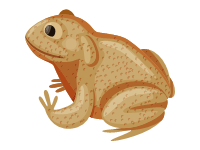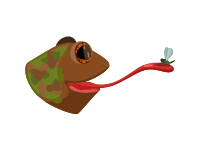| |
Phyllomedusa burmeisteri, also known as Burmeister's leaf frog and common walking leaf frog is a species of frog native to the Atlantic Forest biome in Brazil.Individuals show sexual dimorphism in size. Males have a mean body length (snout vent length) of (63.4 ± 4.5 mm), and females have a mean body length of (76.7 ± 3.2 mm)
| |
Caecilians are a group of limbless, vermiform or serpentine amphibians. They mostly live hidden in the ground and in stream substrates, making them the least familiar order of amphibians. All modern caecilians and their closest fossil relatives are grouped as a clade, Apoda, within the larger group Gymnophiona, which also includes more primitive extinct caecilian-like amphibians. Caecilians are mostly distributed in the tropics of South and Central America, Africa, and southern Asia. Their diet consists of small subterranean creatures such as earthworms.
Caecilians completely lack limbs, making the smaller species resemble worms, while the larger species, with lengths up to 1.5 m (5 ft), resemble snakes. Their tails are short or absent, and their cloacae are near the ends of their bodies
| |
The California toad is a subspecies of the western toad, along with the boreal toad. The California toad lives throughout the state of California, with the exception of south-eastern desert regions.Like the boreal toad, it feeds on a wide variety of insects and invertebrates. Its diet includes grasshoppers, beetles, flies, and mosquitos. The California toad is less blotched (reduced dorsal melanin) than the boreal toad. It has a wider head, larger eyes, smaller feet, and a weaker development of the margins along the dorsal stripe. The largest western toad larvae at 56 mm is also of the California toad. The toad has a wide range of dorsal coloration, from light gray to green to dull black; most however are brownish gray. The California toad, as a western toad, walks rather than hops. The adult size range is two to five inches
| |
The cane toad, also known as the giant neotropical toad or marine toad, is a large, terrestrial true toad native to South and mainland Central America, but which has been introduced to various islands throughout Oceania and the Caribbean, as well as Northern Australia. It is the world's largest toad. It is a member of the genus Rhinella, which includes many true toad species found throughout Central and South America, but it was formerly assigned to the genus Bufo. Тhe cane toad is very large;the females are significantly longer than males, reaching a typical length of 10–15 cm (4–6 in), with a maximum of 24 cm (9.4 in). Larger toads tend to be found in areas of lower population density. They have a life expectancy of 10 to 15 years in the wild, and can live considerably longer in captivity, with one specimen reportedly surviving for 35 years.
The skin of the cane toad is dry and warty. Distinct ridges above the eyes run down the snout. Individual cane toads can be grey, yellowish, red-brown, or olive-brown, with varying patterns. A large parotoid gland lies behind each eye.The ventral surface is cream-coloured and may have blotches in shades of black or brown. The pupils are horizontal and the irises golden. The toes have a fleshy webbing at their base, and the fingers are free of webbing.
Typically, juvenile cane toads have smooth, dark skin, although some specimens have a red wash. Juveniles lack the adults' large parotoid glands, so they are usually less poisonous.The tadpoles are small and uniformly black, and are bottom-dwellers, tending to form schools. Tadpoles range from 10 to 25 mm (0.4 to 1.0 in) in length.
| |
The European green toad (Bufotes viridis) is a species of toad found in steppes, mountainous areas, semi-deserts, urban areas and other habitats in mainland Europe, ranging from far eastern France and Denmark to the Balkans and Western Russia.The spots on the back vary from green to dark brown and sometimes red spots appear, too. The underside is white or very lightly coloured. The European green toad will change colour in response to heat and light changes. Females are larger than males and can lay 9,000 to 15,000 eggs at a time. It can reach a maximum size (head and body length) of 10 centimetres (3.9 in), but growth to this size is rare
| |
The European green toad is a toad found in steppes, mountainous areas, semi-deserts, urban areas, and other habitats in mainland Europe, ranging from far eastern France and Denmark to the Balkans and Western Russia. As historically defined, the species ranged east through the Middle East and Central Asia to western China, Mongolia, and northwestern India, and south through Italy and the Mediterranean islands to North Africa.
The spots on the back vary from green to dark brown, and sometimes red spots appear, too. The underside is white or very lightly colored. The European green toad will change color in response to heat and light changes. Females are larger than males and can lay 9,000 to 15,000 eggs.
It can reach a maximum size (head and body length) of 10 centimeters (3.9 in), but growth to this size is rare.
| |
The golden poison frog (Phyllobates terribilis), also known as the golden frog, golden poison arrow frog, or golden dart frog, is a poison dart frog endemic to the Pacific coast of Colombia. The optimal habitat of P. terribilis is the rainforest with high rain rates (5 m or more per year), altitudes from sea level to 200 m elevation, temperatures of at least 26 °C, and relative humidity of 80–90%. P. terribilis is the largest species of poison dart frog, and can reach a size of 55 mm as adults, with females typically being larger than males. Like all poison dart frogs, the adults are brightly colored, but they lack the dark spots present in many other dendrobatids. The frog's colour pattern is aposematic (which is a warning coloration to warn predators of its toxicity). The frog has tiny adhesive disks on its toes, which aid climbing of plants. It also has a bone plate in the lower jaw, which gives it the appearance of having teeth, a distinctive feature not observed in the other species of Phyllobates. The frog is normally diurnal.
| |
The green salamander (Aneides aeneus) is a species of lungless salamander in the family Plethodontidae. It and the Hickory Nut Gorge green salamander (A. caryaensis) are the only currently-described members of the genus Aneides that inhabit any areas in the eastern half of United States (all other Aneides salamanders are found west of the Mississippi River). Rarely seen in the field, the green salamander is an extremely habitat-specific species that is seldom found away from its preferred surroundings: moist, shaded rock crevices.The green salamander is small and notably flat.The green salamander possesses squared toe-tips, large, conspicuous eyes, and a light blue to yellow ventral surface. Adults range from 8–12 cm (3 to 5 in) with 14 to 15 costal grooves.
| |
The northern leopard frog is a fairly large species of frog, reaching about 11 cm (4.3 in) in snout-to-vent length. It varies from green to brown in dorsal color, with large, dark, circular spots on its back, sides, and legs. Each spot is normally bordered by a lighter ring. A pair of dorsolateral folds starting from the back of the eye runs parallel to each other down the back. These dorsolateral folds are often lighter or occasionally pinkish in colour. Also, a pale stripe runs from the nostril, under the eye and tympanum, terminating at the shoulder. The ventral surface is white or pale green. The iris is golden and toes are webbed. Tadpoles are dark brown or grey, with light blotches on the underside. The tail is pale tan.
| |
oison dart frog (also known as dart-poison frog, poison frog or formerly known as poison arrow frog) is the common name of a group of frogs in the family Dendrobatidae which are native to tropical Central and South America. These species are diurnal and often have brightly colored bodies. This bright coloration is correlated with the toxicity of the species, making them aposematic. Some species of the family Dendrobatidae exhibit extremely bright coloration along with high toxicity, while others have cryptic coloration with minimal to no amount of observed toxicity. Most species of poison dart frogs are small, sometimes less than 1.5 cm (0.59 in) in adult length, although a few grow up to 6 cm (2.4 in) in length. They weigh 1 oz. on average. Most poison dart frogs are brightly colored, displaying aposematic patterns to warn potential predators. Their bright coloration is associated with their toxicity and levels of alkaloids. For example, frogs of the genus Dendrobates have high levels of alkaloids, whereas Colostethus species are cryptically colored and are not toxic.
| |
The southern cricket frog or southeastern cricket frog (Acris gryllus) is a small hylid frog native to the Southeastern United States. It is very similar in appearance and habits to the northern cricket frog, Acris crepitans, and was considered formerly conspecific (Dickerson 1906). The scientific name Acris is from the Greek word for locust, and the species name gryllus is Latin for cricket (Georgia Wildlife). The southern cricket frog is characteristic of coastal plain bogs, bottomland swamps, ponds, and ditches. It prefers sunny areas, and is usually not found in woodlands. Subspecies Acris gryllus gryllus is found in the Atlantic Coastal Plain from southeastern Virginia through the Carolinas, Georgia, Alabama, and Mississippi, west to the Mississippi River. It is found mostly east of the Fall Line, but extends into more upland areas of the Piedmont along river valleys. Subspecies Acris gryllus dorsalis is found throughout the Florida peninsula.
| |
The southern or southeastern cricket frog is a small hylid frog native to the Southeastern United States. It is very similar in appearance and habits to the northern cricket frog. The southern cricket frog feeds on insects, spiders, and other arthropods. It is active throughout the year in warm weather. Breeding is in late spring and summer. The advertisement call of the males is a loud, rapid gick, gick, gick. Up to 150 eggs are laid at a time, and more than one mass may be produced in a season.
| |
A tadpole (also called a pollywog) is the larval stage in the life cycle of an amphibian. Most tadpoles are fully aquatic, though some species of amphibians have tadpoles that are terrestrial. Tadpoles have some features that may not be found in adult amphibians such as a lateral line, gills, and tails. As they undergo metamorphosis, the diet of tadpoles changes and they will start to breathe air.
| |
The Texas toad (Anaxyrus speciosus) is a species of medium-sized (to 9 cm (3.5 in)) toad that occurs in the southern United States and northern Mexico.It breeds in temporary water pools after heavy rains.Males measure 52–78 mm (2.0–3.1 in) and females 54–91 mm (2.1–3.6 in) in snout–vent length. The Texas toad is native to the United States where it is found in the state of Texas (in 2009 it was designated as the Texas State Amphibian), its range also extends northward to Oklahoma, westward to New Mexico and southward to northern Mexico. It is a desert species and is found in dry grassland, savannahs with scattered mesquite and open woodland, usually on sandy or frequently inundated soils.
|
|


